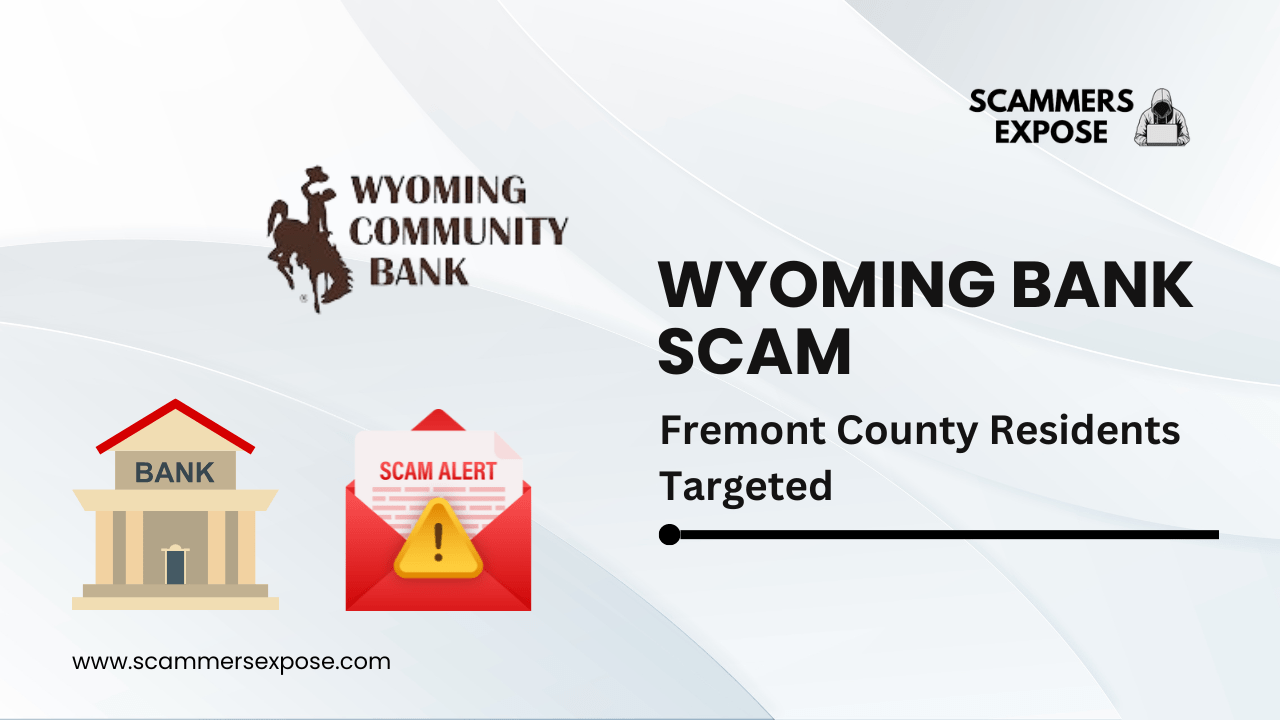The Wyoming Bank Scam is actively targeting Fremont County residents with fraudulent text messages posing as alerts from local banks. These scams aim to steal sensitive financial information through phishing links and spoofed phone numbers. Staying informed about how this scam operates and recognizing the warning signs is key to protecting your personal information and finances from these malicious attacks.
Introduction to the Wyoming Bank Scam
Fremont County residents are currently facing a wave of fraudulent activities. Recently, many have reported receiving deceptive text messages claiming to be from Wyoming Community Bank. These messages, part of the larger Wyoming Bank Scam, attempt to trick recipients into sharing personal and financial information. As more locals become targeted, it’s critical to stay vigilant and informed.
How the Wyoming Bank Scam Operates
- Fake Alerts: The scam typically involves a text message warning about suspicious transactions, urging the recipient to verify their banking information.
- Phishing Links: These messages contain malicious links directing individuals to a fake website resembling the actual bank’s login portal.
- Personal Data Theft: Once users enter their credentials, scammers gain access to sensitive data, including banking details, PINs, and passwords.
Specific Example of the Scam
One example circulating in Fremont County involves messages that claim a large purchase was made with the victim’s debit card. The message prompts the individual to click a link to “stop the transaction.” This tactic capitalizes on fear and urgency, leading people to act quickly without verification.
Impact on Fremont County Residents
- Increased Targeting: Local banks like Wyoming Community Bank have issued warnings as many Fremont County residents report receiving these scam messages.
- Financial Risks: Victims who fall for the scam may have their bank accounts compromised, leading to fraudulent withdrawals or identity theft.
Warning Signs to Recognize
- Urgent Language: Messages often claim immediate action is needed due to suspicious account activity.
- Unfamiliar URLs: Fake messages typically direct users to look-alike websites with URLs that don’t match the official bank’s website.
- Request for Personal Information: Legitimate banks never ask for sensitive details like PINs, passwords, or account numbers through unsolicited texts.
Steps to Protect Yourself from the Wyoming Bank Scam
- Do Not Click Links: If you receive a suspicious message, avoid clicking any links. Instead, contact your bank directly using a verified phone number.
- Report the Scam: Forward phishing texts to your mobile carrier at SPAM (7726) or report them to local authorities.
- Monitor Bank Accounts: Regularly check your bank statements for unauthorized transactions, especially after receiving suspicious messages.
By staying cautious and following best practices, residents of Fremont County can protect themselves from falling victim to the ongoing Wyoming Bank Scam.
How the Scam Works
The Wyoming Bank Scam targeting Fremont County residents typically unfolds through unsolicited text messages, claiming issues with the recipient’s bank account. These messages often state that suspicious activity has occurred, or that immediate action is required to prevent further issues. Victims are encouraged to click a link to resolve the matter, but the link instead leads to a phishing website designed to harvest sensitive information.
Key Scam Tactics:
- Impersonation: The text messages mimic official communications from Wyoming Community Bank, using similar logos and branding to appear legitimate.
- Urgent Claims: Messages emphasize urgency, warning recipients about potential account freezes, fraud, or other issues that require immediate action.
- Spoofed Numbers: Scammers may use phone numbers that closely resemble or even match the bank’s official contact numbers, further convincing victims of their legitimacy.
- Phishing Websites: Clicking the provided links directs users to fraudulent sites that replicate the bank’s login page. Victims are prompted to enter their banking details, such as usernames, passwords, and even personal identification numbers (PINs) or social security numbers.
Types of Fraudulent Messages
Several variations of these scam messages have been reported, but most follow a similar structure. Common examples include:
- Notifications about suspicious withdrawals or purchases on the victim’s account.
- Alerts regarding changes to account details like email addresses or phone numbers.
- Messages stating the account will be locked unless immediate action is taken.
Sophistication of the Wyoming Bank Scam
As the Wyoming Bank Scam evolves, it has become more sophisticated. Scammers now use advanced techniques to avoid detection and lure victims into their traps:
- Fake URLs: These phishing sites are often near-identical copies of official bank websites, making it difficult for users to distinguish between real and fake.
- Data Theft: Once personal details are entered on these fake sites, scammers can use them to initiate fraudulent transactions, gain access to bank accounts, or even steal identities.
- Malicious Software: In some cases, clicking the scam link may trigger the download of malware, compromising the victim’s phone or computer and enabling ongoing access to their data.
Protecting Against the Wyoming Bank Scam
To protect against the Wyoming Bank Scam, Fremont County residents should:
- Verify the Source: Always check the legitimacy of unsolicited messages by contacting your bank directly through official channels.
- Avoid Clicking Links: Never click on links sent through unsolicited text messages or emails. Instead, manually type the bank’s URL into your browser.
- Monitor Account Activity: Regularly review your bank statements for any unauthorized transactions.
- Enable Multi-Factor Authentication (MFA): MFA adds an extra layer of security to your bank account, making it harder for scammers to gain access, even with stolen credentials.
By understanding how the Wyoming Bank Scam operates and recognizing the tactics scammers use, individuals can better protect themselves from falling victim to these fraudulent schemes.
Statistics and Impact
According to recent reports, the Wyoming Bank Scam has affected approximately 5% of Fremont County residents in the last month alone. Alarmingly, the number of affected individuals has been doubling every week, indicating a growing sophistication in the scammer’s tactics. Data from Internet security firms highlight that phishing scams like these lead to identity theft in over 25% of cases.
| Week | Number of Affected Residents |
|---|---|
| Week 1 | 50 |
| Week 2 | 100 |
| Week 3 | 200 |
| Week 4 | 400 |
Protecting Yourself from the Scam
Protecting yourself from the Wyoming Bank Scam requires taking specific precautions to prevent falling victim to these fraudulent attempts:
- Verify the Source: Always contact Wyoming Community Bank directly through official and trusted communication channels, such as their verified website or customer service number.
- Avoid Clicking Links: If you receive a suspicious message, never click any included links. Instead, manually enter the bank’s URL in your browser.
- Monitor Your Accounts: Regularly review your bank accounts and statements for any unusual or unauthorized transactions to catch fraud early.
- Report Suspicious Messages: Forward any suspicious texts or emails to the bank’s fraud department to help prevent further scams and to aid authorities in tracking the perpetrators.
Bank’s Response and Community Efforts
In response to the Wyoming Bank Scam, Wyoming Community Bank has taken proactive measures to protect its customers. The bank regularly issues public alerts, educating its customers on how to spot potential scam messages and phishing attempts. These alerts emphasize caution, directing customers to use secure methods of communication when verifying messages.
Local law enforcement and consumer protection agencies are also working together with Wyoming Community Bank. Their collaboration includes tracking down the origins of these scam messages and attempting to bring the fraudsters to justice. Their efforts underscore the importance of community vigilance and prompt reporting.
Additional Security Measures to Consider
- Enable Two-Factor Authentication (2FA): For extra security, use 2FA when logging into your online bank account. This requires a secondary verification step, making it harder for scammers to access your account, even if they obtain your login credentials.
- Set Up Account Alerts: Many banks offer notifications via email or text for any transaction made. This can quickly alert you to unauthorized activity and enable swift response to potential threats.
- Use a Secure Wi-Fi Connection: Avoid accessing your bank accounts over public or unsecured Wi-Fi networks, which could leave your information vulnerable to hackers.
By taking these steps, Fremont County residents can effectively safeguard themselves against the ongoing Wyoming Bank Scam.
Conclusion
The Wyoming Bank Scam continues to target Fremont County residents through deceptive text messages designed to steal sensitive information. These fraudulent messages pose as legitimate alerts from Wyoming Community Bank, tricking recipients into clicking malicious links or providing personal data. Staying informed about the methods scammers use, such as phishing and phone number spoofing, is crucial to preventing identity theft and fraud.
To help residents stay protected, local banks, law enforcement, and consumer protection agencies are working together to combat the growing threat. By staying proactive, Fremont County residents can avoid falling victim to the Wyoming Bank Scam.
Additional Resources for Staying Safe
To remain updated on the latest developments related to the Wyoming Bank Scam, check out resources like Scammers Expose for current alerts on financial fraud. These platforms provide detailed guidance on identifying scams and staying one step ahead of potential threats.
For comprehensive advice on protecting your personal and financial information, Wyoming Community Bank offers educational resources through their website and public alerts, ensuring that customers are aware of the tactics scammers employ in these deceptive schemes. Keep an eye on local news outlets for updates on new scam tactics affecting the community.
Visit our news section to stay updated with the latest developments in the case. For more insights into financial fraud and investor protection, visit Scammers Expose.

